Unai Emery‘s Aston Villa were one of the sensations of the Premier League 2022/23. After a very complicated start to the season that ended in the dismissal of Steven Gerrard as manager, the Spanish tactician arrived in November and, since the first game (a surprising 3-1 victory over Manchester United), managed to stamp his tactical stamp on a team that did not stop growing in the rest of the season, until obtaining seventh place in the table and qualifying for the Conference League 2023/24, thus managing to play in European international competition after more than a decade.
The Villans went on a remarkable 10-match unbeaten run between 25 February and 25 April and were particularly notable for their playing style and the way they were able to adapt to each opponent by sticking to their game plan and developing it throughout the matches. And if Emery was able to do this with little time, it is normal that there is a great expectation of what he can do for the season 2023/24 with much more time to work, greater knowledge of the team and some world-class reinforcements that will seek to raise the team’s performance.
Signing players like Pau Torres, Youri Tielemans, and Moussa Diaby automatically raises the club’s aspirations. However, it also shows how the whole project has grown in different areas thanks to other signings made – Monchi, Sevilla’s former sporting director and Unai Emery’s right-hand man through many successful years, is now part of the English club as president of football operations.
So, in tactical analysis format, we will detail how Aston Villa had a stupendous season in the Premier League, became the most fouled team in the league due to the development of their key attacking talents and what might be expected of them for a new season with very different objectives.
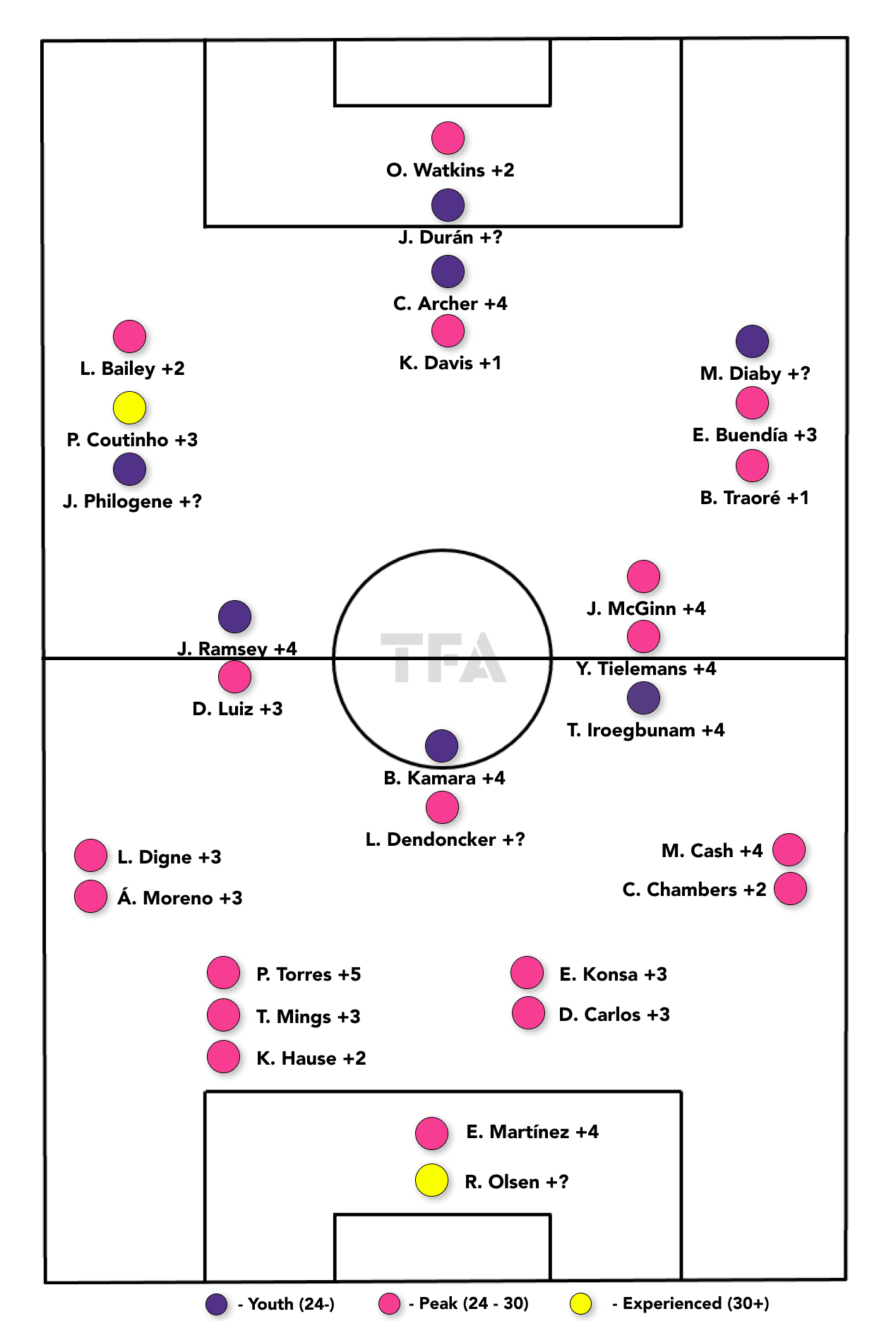
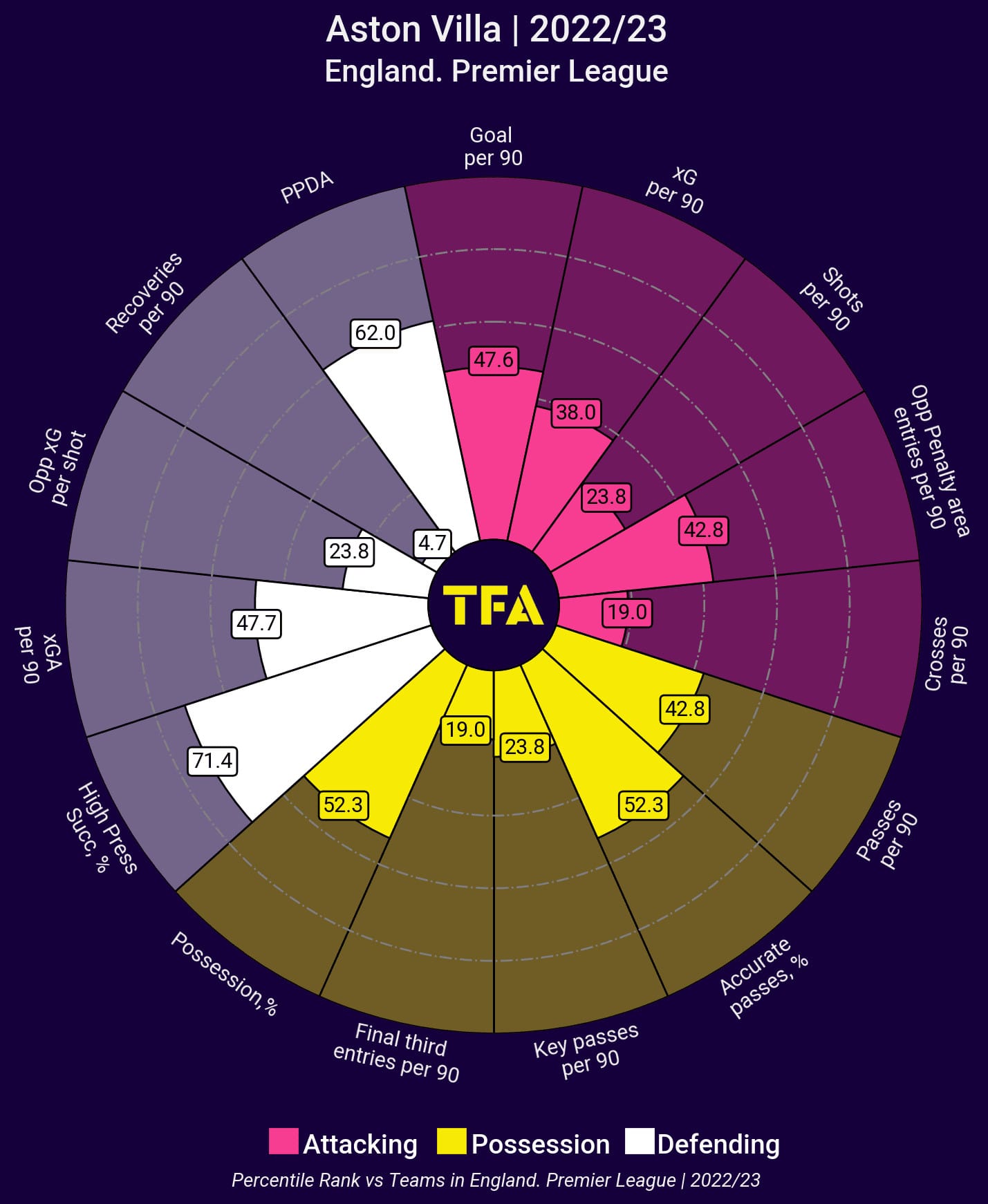
Attacking phase
One of the primary keys to Unai Emery’s success at Aston Villa has been the empowerment of his attacking players through attacking dynamics that enhance the reception of pieces in critical areas to be as productive as possible in the opposition half. Generally, it is a team with highly developed resources to overcome high pressures and open up low blocks that can vary their intentions according to the opposition’s defensive approach.
In the two systems used this season (4-4-2 and 4-2-3-1), although generally opting for a 4-2-2-2-2 shape according to the role of all players, the double pivot has vital importance in the build-up phase of the team. Both players, usually Douglas Luiz and Boubacar Kamara, coordinate very well to offer themselves as a passing option behind the first line of pressure and to be able to get the ball from the last line to distribute.
In this sense, the intention of the other CM who does not receive the ball is key, who generally chooses to advance metres up the pitch to not only create another passing line but to attract one of the opposing midfielders and give the ball holder more time-space to pass.
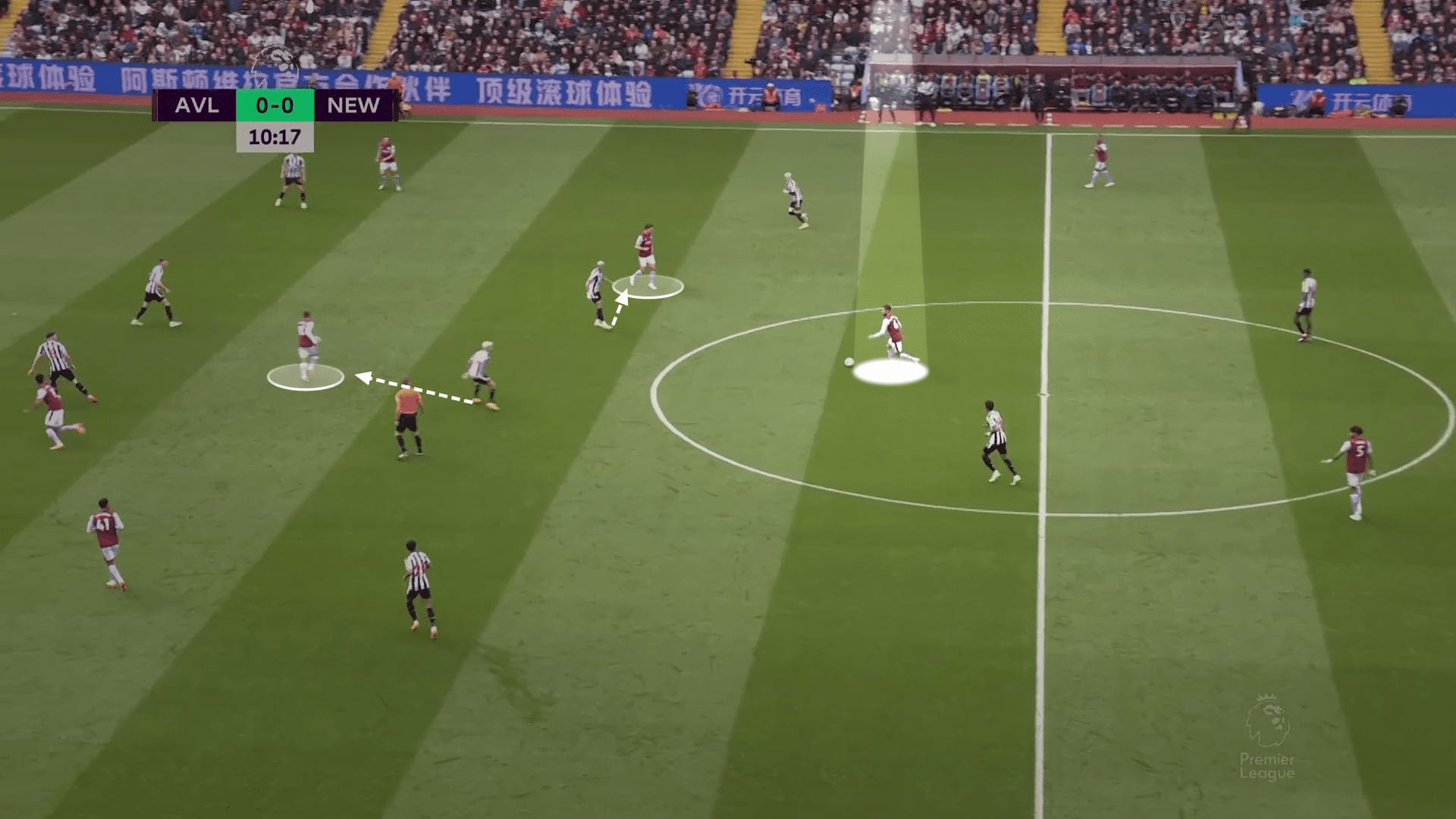
The use of the double pivot to create passing lanes in the first phase is a handy resource against teams that press with their front line but are not as aggressive with their midfielders or, on the contrary, their attempts to press are very uncoordinated and leave a lot of space inside the block.
However, against more intense/aggressive teams who use all their pieces to press in the opposition half, Emery’s Aston Villa often use their double pivot as an element of attraction to draw the opposition midfield out of their zone, and there are a couple of scenarios where the club is very dominant.
The first is the use of Ollie Watkins as a target man. The 27-year-old centre-forward is a player who wins the majority of duels and aerial balls he contests because of the excellent use of his body to get past opponents. He is comfortable holding opponents at his back and using his link-up play to connect with players close to him, although he could be more accurate in setting up his team in the opposition half.
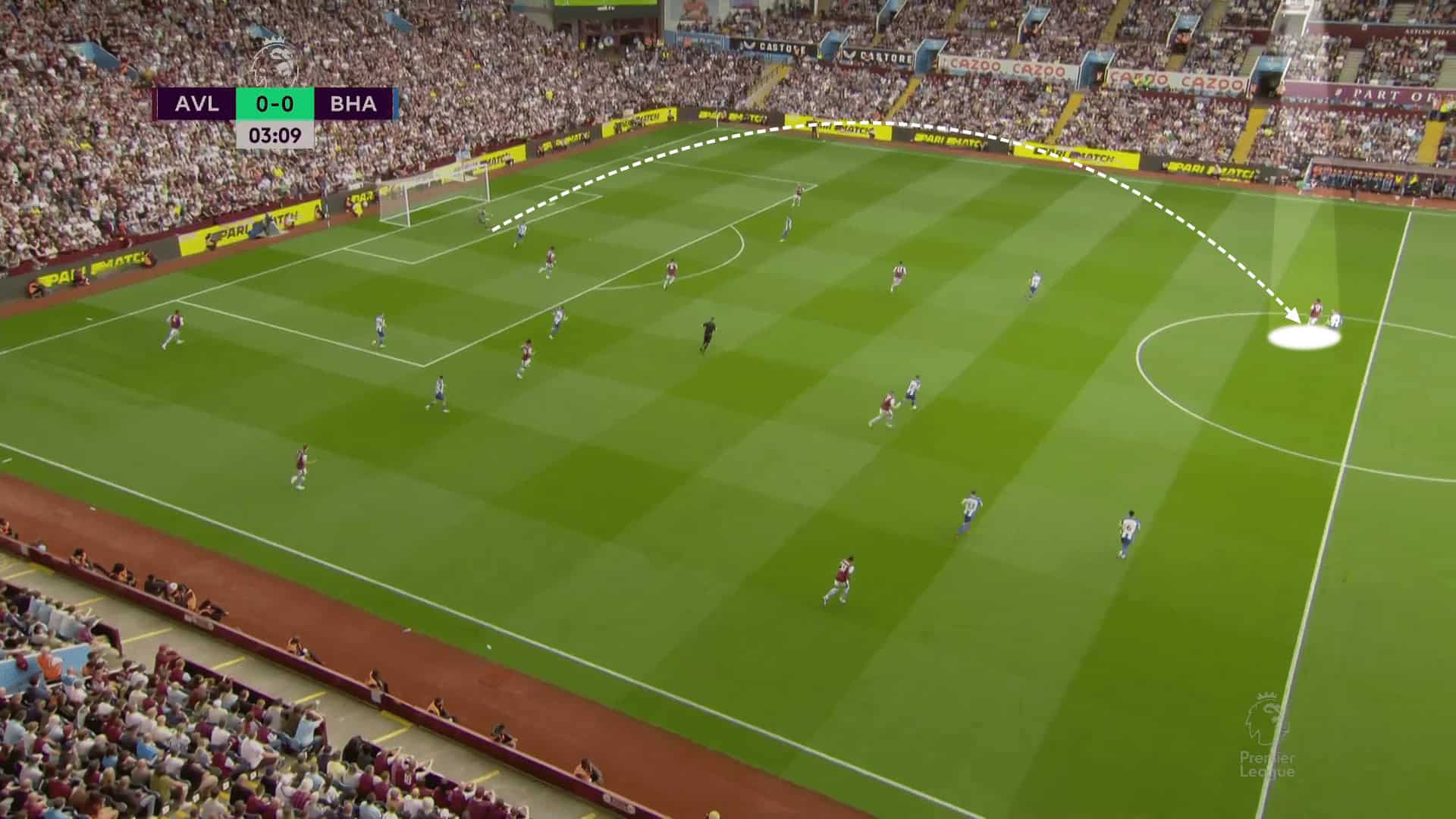
The second scenario is a much more dynamic and convenient one for the team, using wingers or double #10s (Emiliano Buendía, generally, but also Jacob Ramsey) in half-spaces + FBs in the second phase setting width that greatly condition the decisions of the opposing full-backs. If the opposing midfield is drawn in, the attacking pieces have more time and space to receive and turn inside if the opposing full-back doesn’t come out of the area. If he does, Villa’s FBs have time to progress out wide carrying the ball, especially Álex Moreno.
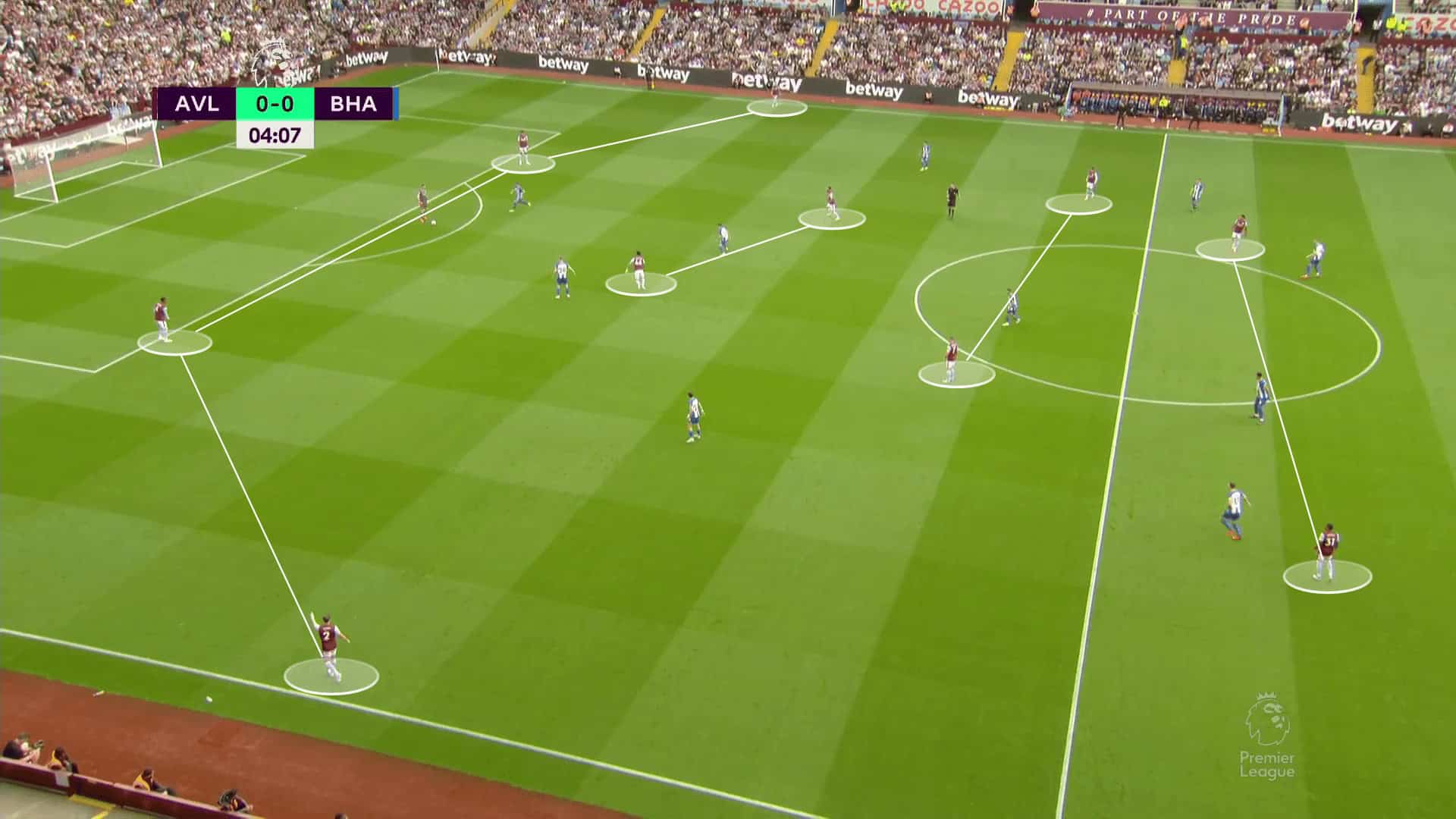
Also crucial to this whole process is the mobility of Ollie Watkins to threaten the back line through his powerful off-the-ball movements to create scoring opportunities. Suppose the opposing defensive line comes out of position too much or needs to be more aggressive in marking players in half-spaces. In that case, it can develop exploitable cracks for the striker to be activated with a pass into space.
In January 2023, Unai Emery exclusively requested the signing of Álex Moreno, a left-back who stands out for his power and speed. Two days after making his arrival official, the player started against Leeds and did not miss a single game for the rest of the season, except the last game against Brighton.
The Spanish player is a vital part of the playing philosophy, as in a team that accumulates many pieces on the inside and compresses the opposing block, he usually has more space to carry the ball and progress. In addition, his pass-and-go is really positive to exploit advantages when attacking.
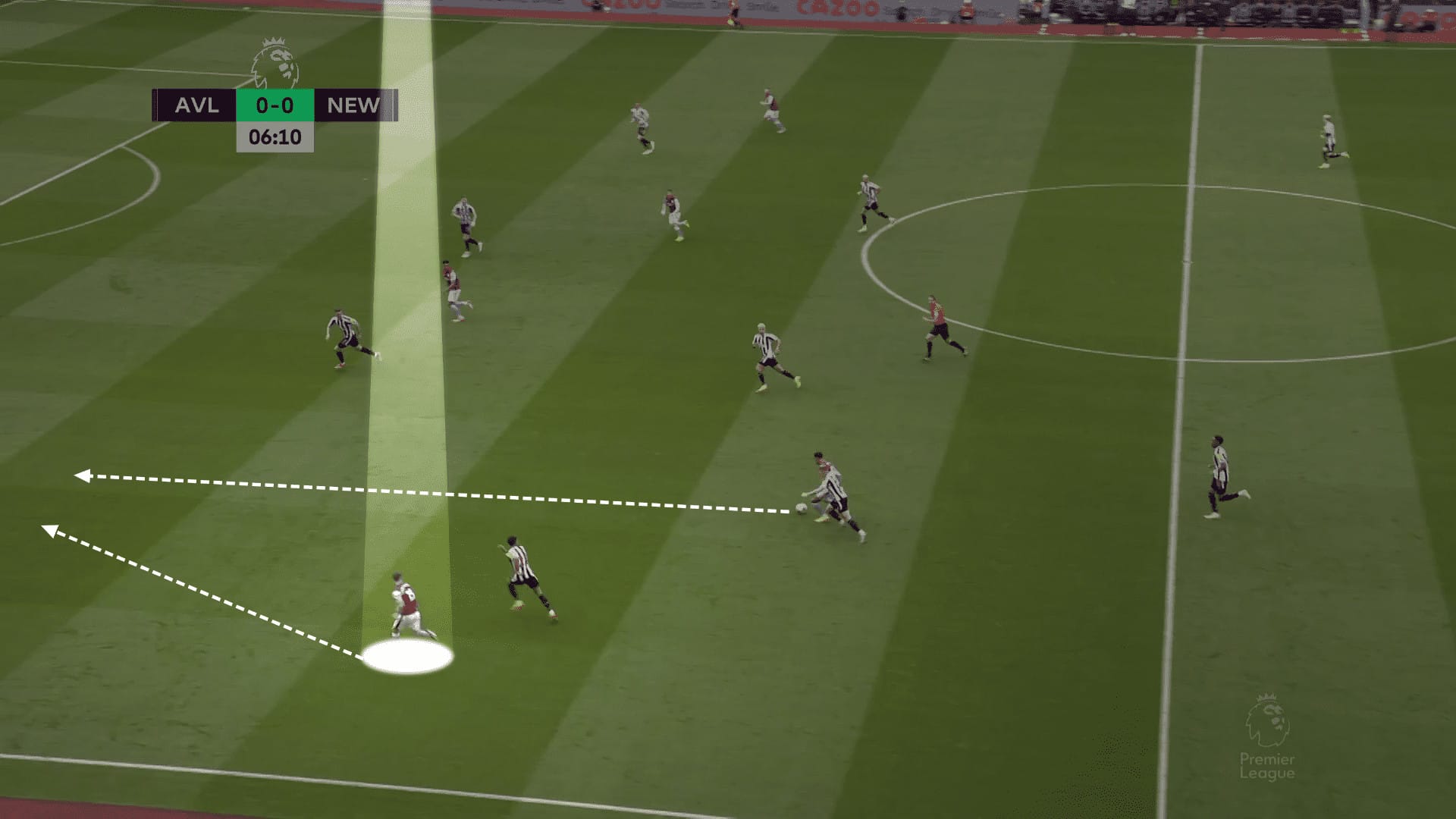
However, the most decisive and productive piece in Aston Villa’s attacks is Emiliano Buendía, a player that Emery has been able to strengthen in different positions but always focused on appearing inside, turning and exploiting his vision to create goal-scoring opportunities. In a team that manipulates opposing pressure very well by drawing men into their own half and Watkins often stretches the back line because defenders avoid his unmarked moves behind his back, the Argentine usually finds enough space in the midfield to turn and be the team’s creative organiser.
While last season he did not particularly stand out in numbers (five goals and two assists), his impact on the game was very much related to the number of scoring chances the team created and the ability to overcome various defences.
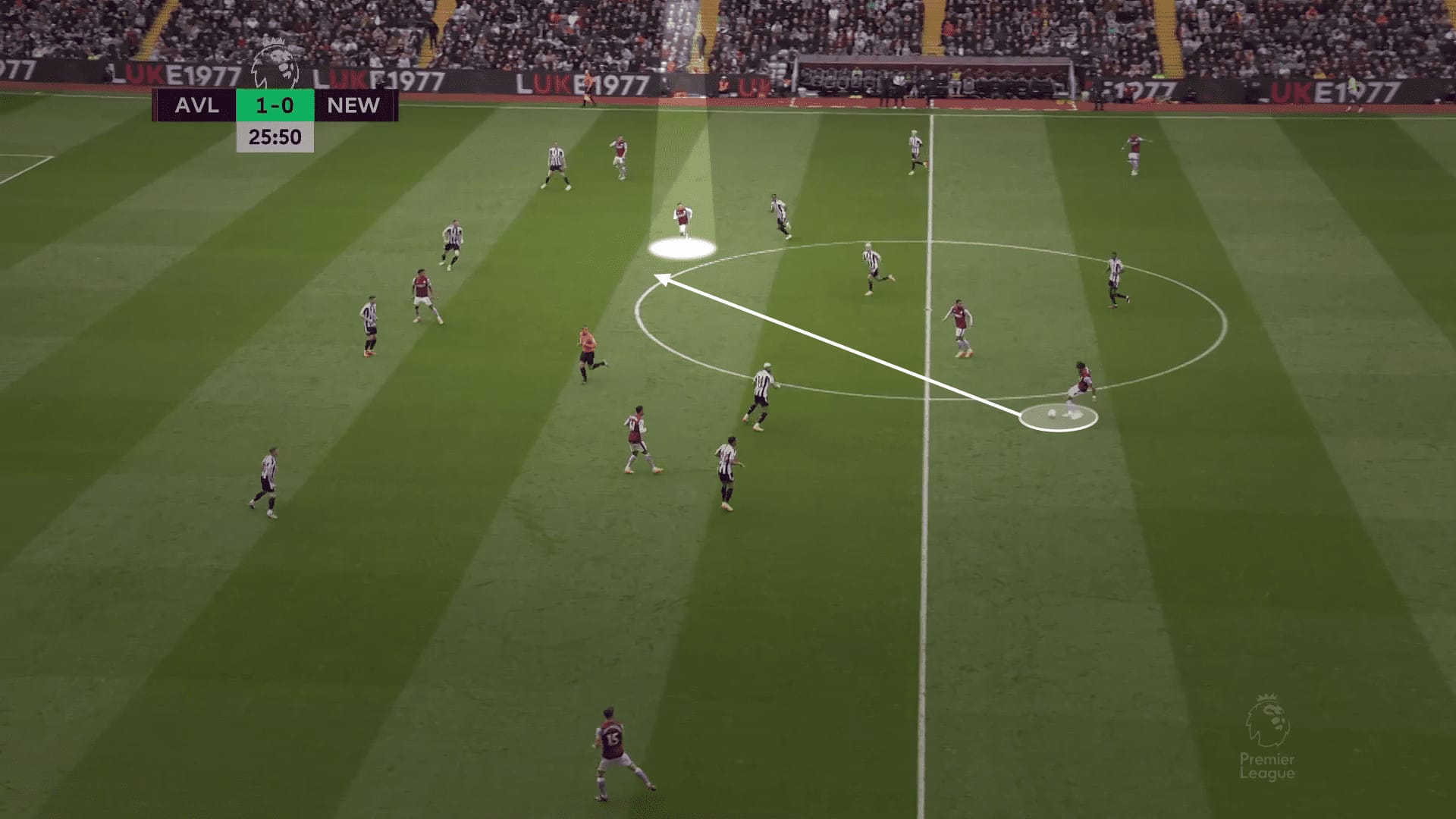
In general, Unai Emery’s Aston Villa is a team with resources and dynamics that are very useful in different scenarios, allowing them to perform well last season. Moreover, signing Pau Torres, Youri Tielemans, and Moussa Diaby should make them a much more imposing and dominant team in their possessions, as (with the exception of Tielemans) their arrivals are not exactly market opportunities, but significant investments made to improve areas of the team and polishing details to be more and more effective in their intentions, as well as creating new useful contexts.
Defensive phase
Since Unai Emery arrived at The Villans, one of the main signs of the effectiveness of his methodology has been the defensive block. Aston Villa became a team capable of defending very solidly and aggressively in different areas through micro-details that were strengthened over the course of the season.
In general, it is a team that uses the 4-4-2 system to defend, and the height of its block varies according to the dynamics of the opponent’s build-up phase or the threat they have in attack. However, the scenario they looked for the most during the last season (and will hopefully continue to refine during the 2023/24 Premier League) is to have a medium-high defence that is very gifted at creating frequent offside traps.
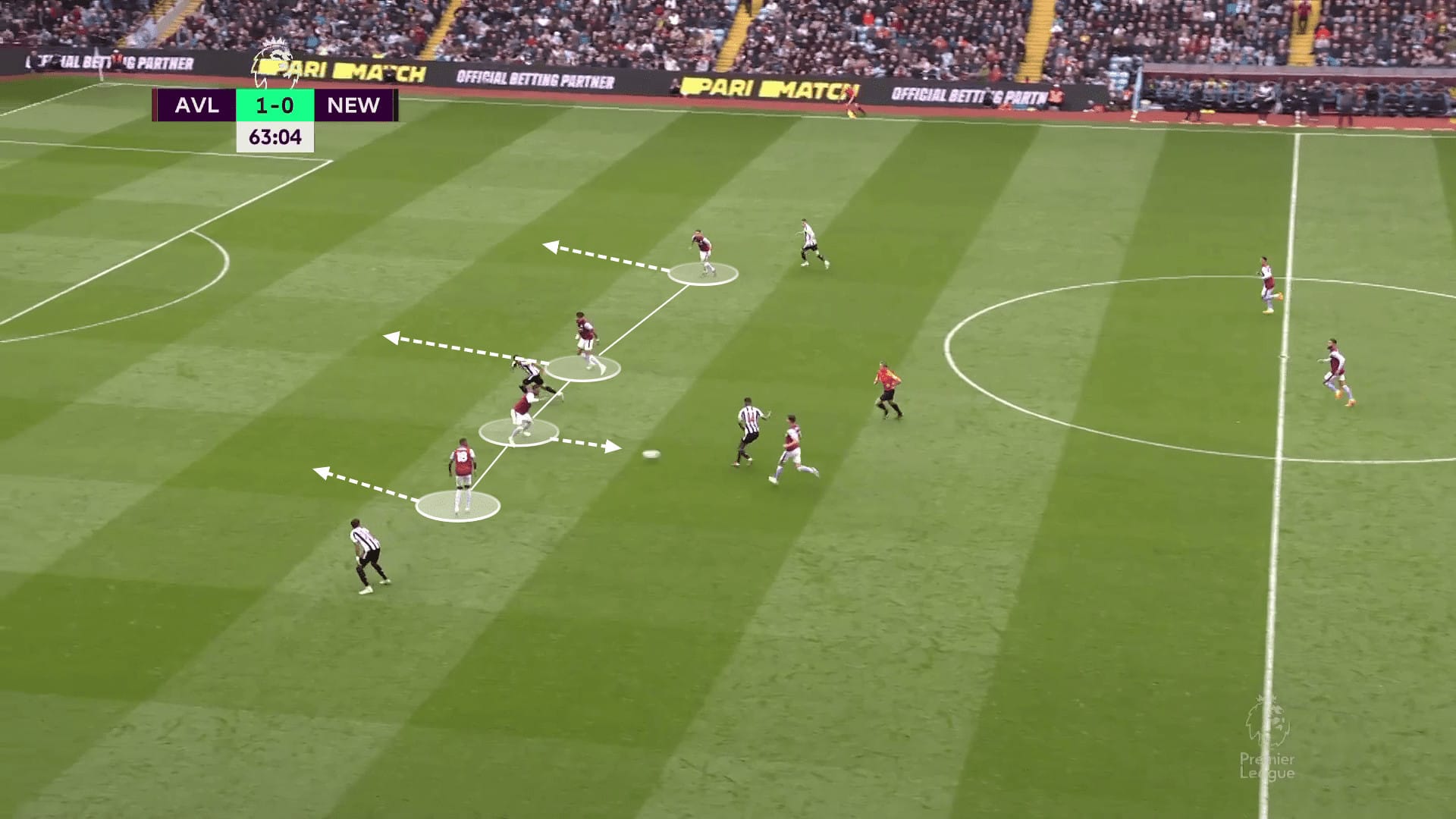
It is a team endowed with exquisite pieces and concepts to defend in a high block, also creating very useful oriented pressure traps that lead the opponent to connect with a “free” centre-back or full-back that Aston Villa then completely controls by reducing their close passing options and approaching him.
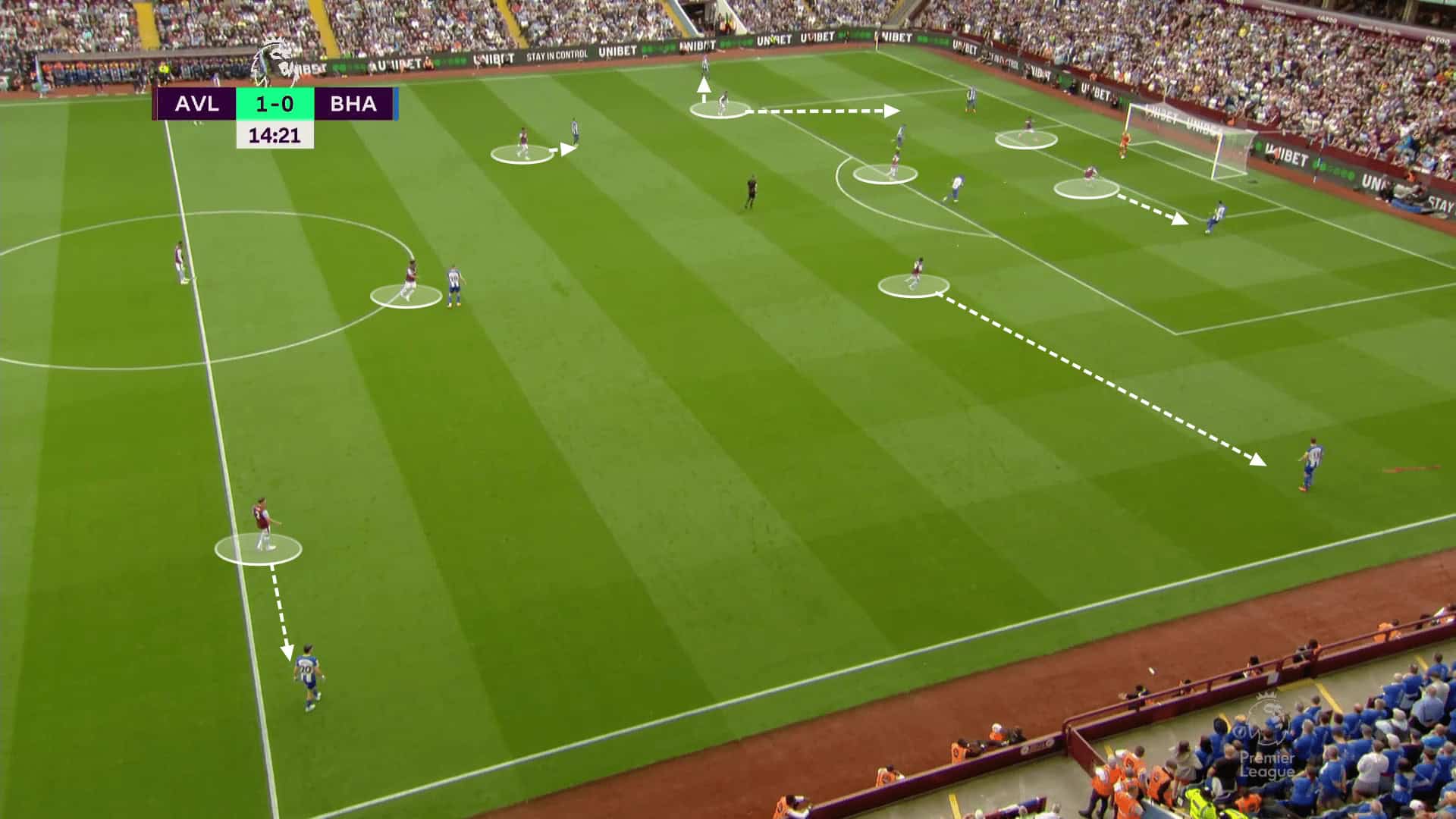
In addition, should the ball-holder use the long pass into space, the back line has two centre-backs who are strong in duels and have good pace to defend extensive areas behind them. Still, they are particularly good at coordinating their steps forward and playing the offside trap.
One of the most exciting micro-details of the defensive line lies in the defensive profiles that players use when the opposition prepares to give a key pass – although they often recommend defending laterally (oriented to start faster and defend the space), the nearest centre-back often marks the height of the defensive line by being as far in front of the ball-holder as possible to have a longer reach and intercept his pass. In this way, he organises the offside trap and has a better chance of recovering the ball. It is a risky exercise requiring a lot of coordination, but one that has allowed Aston Villa to be dominant in this type of situation.

It is also possible to observe these concepts in the full-backs when defending passes into space, often turning their backs to the running player to constantly visualise the last line to know when to stop and prioritise the coordination that allows the offside trap.
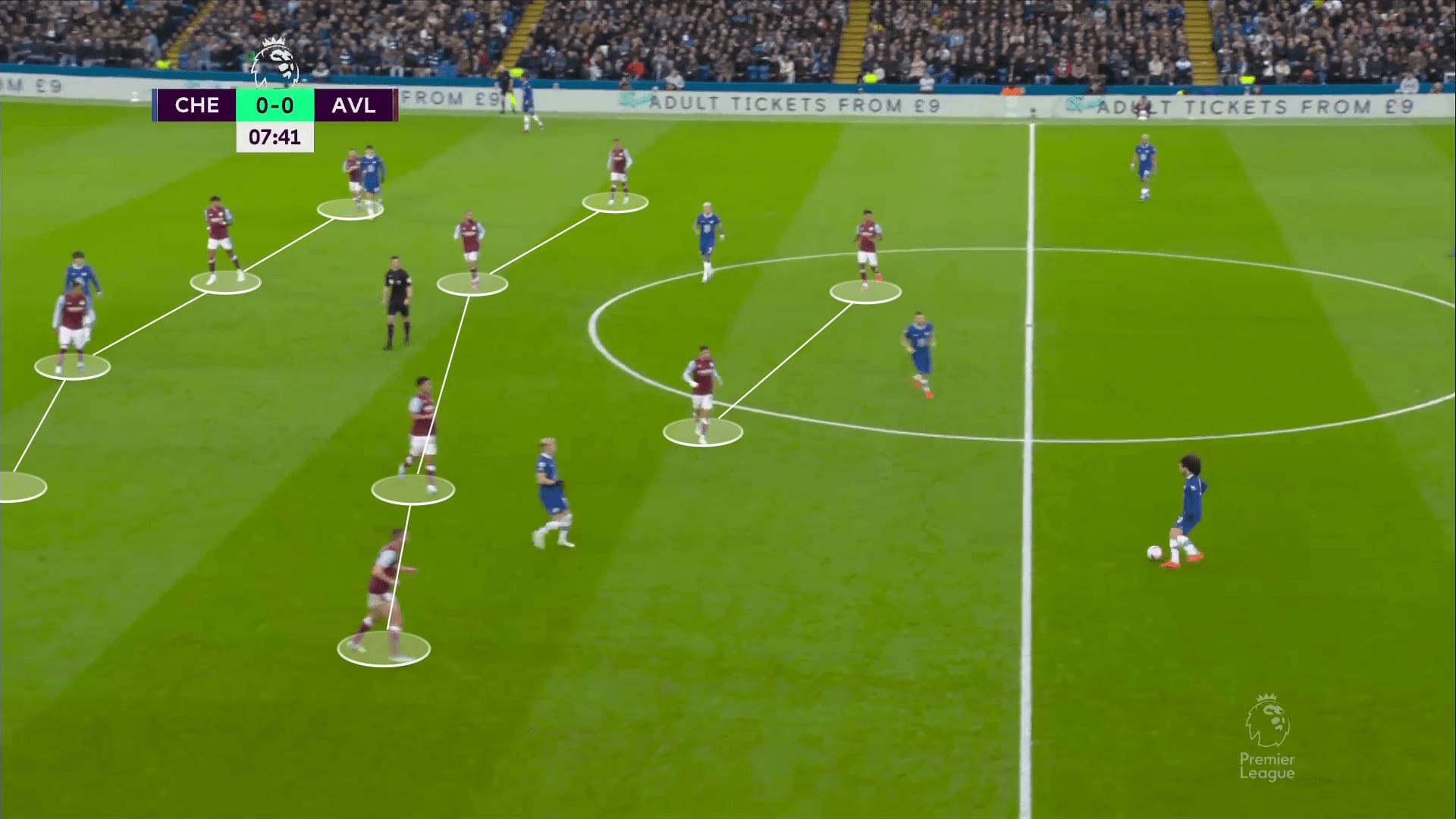
In mid-low defence scenarios, the team seeks to keep its lines very compact. It does not allow progressions inside, forcing the opponent to progress on the outside, with greater possibilities of stealing in 1v1. However, on many occasions, there is room for improvement in the coordination of the double pivot that falls into traps of attraction or suffers when managing a numerical inferiority without prioritising the balance of the block.
Transitions phase
Due to the playing style of the team’s players, Aston Villa is a very aggressive team in their attacking transitions, especially when they detect a minimum of space for counter-attacks. The speed of Álex Moreno, Buendía’s play between the lines, Kamara/Luiz’s passing range and Watkins’ aggressive movement (in addition to everything he can offer as a target man) are more than enough arguments to be a vertical and intense team after winning the ball back in the opposition half.
Emery has very threatening pieces in different positions that allow the team to be rapid and aggressive, exploiting advantages against poorly positioned opponents or with minimal space in their block where many benefits can be born.
In addition, two new faces will be essential for this season: Pau Torres and Moussa Diaby. While the former has an excellent passing range to progress, the latter is an ideal ball carrier, speedy and self-sufficient enough to create or finish dangerous chances in numerical or positional inferiority.
In defensive transitions, the team’s approach varies depending on the opponent and the area of the pitch where the ball is lost. However, they tend to be an active team in their front line to counter-press, although sometimes they tend to have some problems in the positioning of their back line, giving their opponents a lot of space to play long passes.

At times, Aston Villa have suffered from a distributor with time and space (after overcoming the front line or because of a more passive team approach) with a very high back line, taking significant risks to execute the offside trap. While team coordination is usually positive, in such fast-paced scenarios, especially when facing teams with a high ability to conquer the back of the opposition defence, the approach could be less aggressive in order to have better control of the opposing counter-attacks.
How do the new signings change/improve Emery’s game idea?
Aston Villa have made three signings for this season: Moussa Diaby (€55,000,000), Pau Torres (€33,000,000) and Youri Tielemans (free transfer). All three aim to become first-team starters and considerably improve the current performance, making The Villans increasingly dominant in familiar scenarios and, in turn, a flexible team to do damage in other contexts.
Starting with the back line, Pau Torres is an LCB with ideal technical-tactical attributes to be one of his team’s leading distributors through his passing range and pass selection, which is why he excelled at Villarreal over the last few years and was even crucial in Luis Enrique’s Spain. His ability to progress is far superior to that of Tyrone Mings, so the team could exploit many more advantages by attracting opposition pressure and connecting with players between the lines or attacking space.
Unlike Mings, he is also a very dominant player in duels, but not so much in the air. He knows how to defend in a high block and has been coached by Unai Emery in the past, which makes even more sense for his acquisition, but he will need to be a much more solid player against the power, strength and height of many of the Premier League strikers to be as effective in the defensive phase of the game.
Youri Tielemans, a player who Big Six clubs had tracked in recent years, will bolster Villa’s midfield, giving the team three well-rounded profiles capable of performing mixed roles for the double pivot – Luiz, Kamara and Tielemans.
The Belgian could positively impact as a dynamic distributor, popping up in the first and second phases and improving the quality of his team’s attacks through his passing range. He is bolder in his intentions than Kamara and Luiz to enable more connections between the lines with Buendia. However, he will be strong competition from day one to determine the starters in midfield.
Moussa Diaby is Aston Villa’s star signing and one of the most exciting signings in the Premier League 2023/24. He was a player linked with Champions League clubs and chose The Villans to develop his career further. He is a winger who can play on both flanks and be key in Emery’s game idea with two #10s with the freedom to appear on the wing or inside and dynamise attacks.
The former Bayer Leverkusen is a mighty player to carry the ball and with excellent technical-tactical attributes to exploit spaces and generate or finish scoring chances. In addition, his self-sufficiency and speed to attack the back of the last line will also be very useful in the team’s attacking dynamics.
Key Player: Ollie Watkins
In a team as complete and balanced as Unai Emery’s Aston Villa, the most decisive figure is Ollie Watkins, a striker who scored 16 goals and provided six assists last season. However, he is essential not only for his goalscoring impact but also for his contribution to the playing philosophy to attack space and condition the positioning of the last line or be directly activated as a target man to allow his team to settle in the opposition half, although there is still room for improvement in this respect.
Watkins is a very powerful centre-forward at 27 years of age who understands the Spanish coach’s playing philosophy quite well and could have an equal or more significant impact this season by reinforcing the attacking dynamics so that The Villans are increasingly dominant in possession.

One to watch: Moussa Diaby
Moussa Diaby is the most expensive signing in Aston Villa’s history, as the English side paid Bayern Leverkusen 55 million euros for his signature. The French-Malian arrives after being one of the standout performers of the Bundesliga 2022/23, scoring 14 goals and providing 11 assists in different competitions, as well as being a very impactful winger in his playing style due to his speed and power to carry the ball and generate or finish dangerous chances.
He will have an ideal scenario to enhance his game by appearing in different areas and being activated frequently, so it is expected a very favourable performance in the Premier League 2023/24 within a team that seeks to continue polishing details of his game idea and dominating new scenarios with him as one of the leading players.
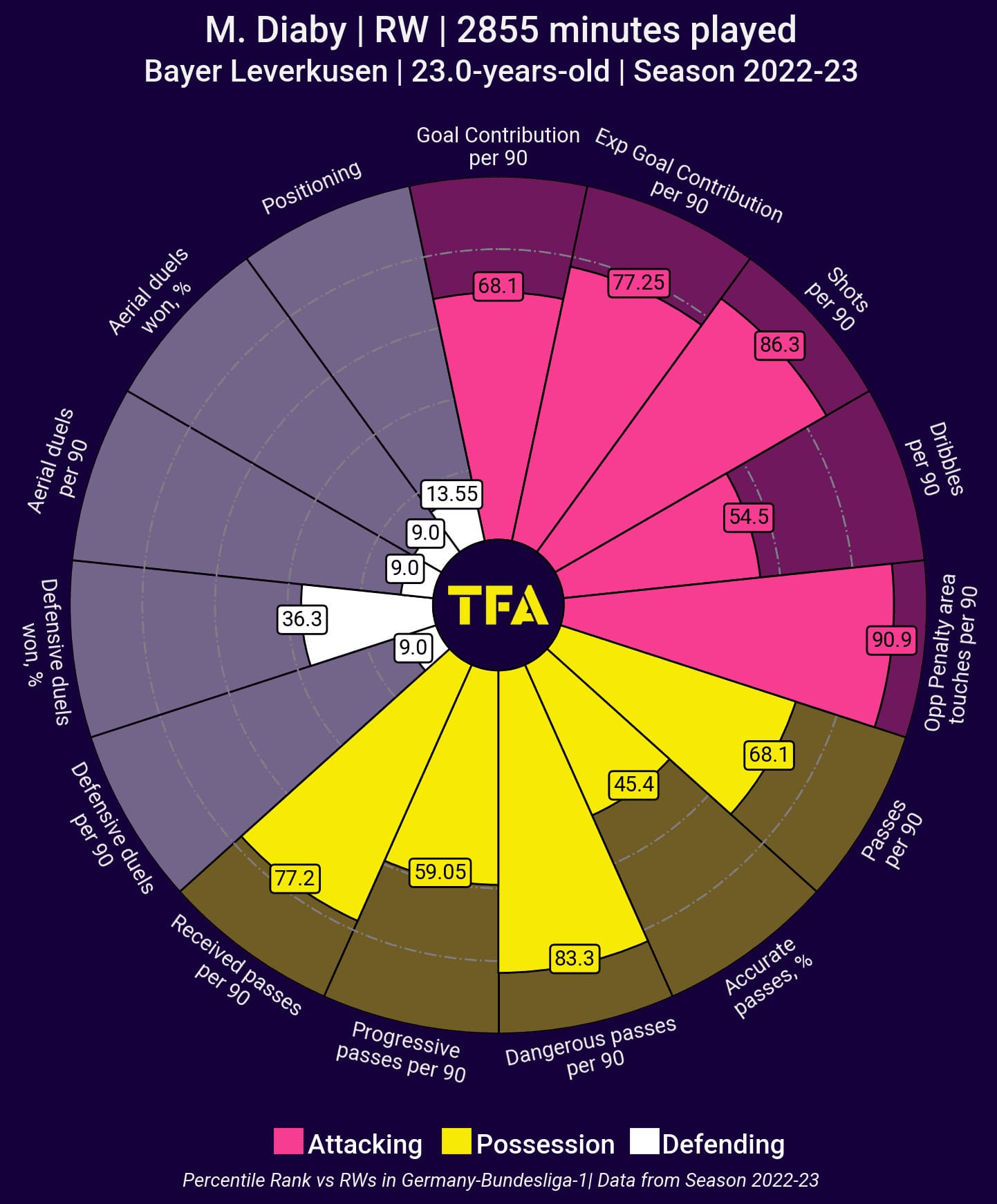
TFA Verdict: 7th
What’s not to like about what Unai Emery is doing at Villa Park? The squad is stronger than last season. He’s had a full preseason to get his ideas even more ingrained than he managed in record quick time last season. A midfield of Ramsey, Douglas Luiz, Kamara, McGinn and freebie Tielemens is possibly the best outside the traditional powerhouses and certainly better than Tottenham’s. 7th will see them challenge for Europe once more and maybe a good run in a cup or two.





Comments